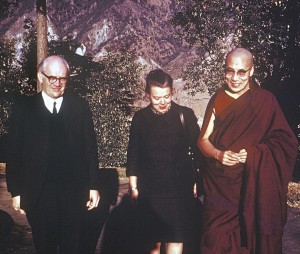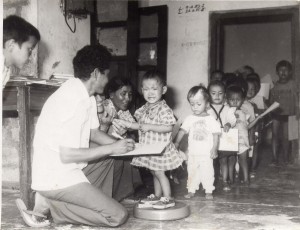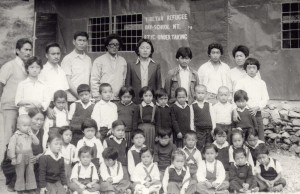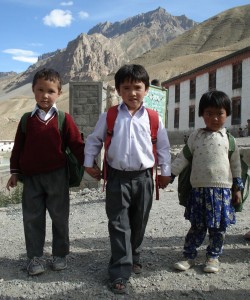TRAS was founded in 1962 by George and Inge Woodcock of Vancouver in response to the plight of Tibetan refugees who had fled from their homeland after the Chinese communist occupation of Tibet and the failure of the Tibetan uprisings in Lhasa in 1959.
The Tibetans traveled to neighboring countries of India, Nepal and Bhutan under great hardship, across some of the world’s highest and most rugged terrain, fleeing with virtually no possessions. Many died on the way, so that by the time the approximately 80,000 exiles reached safety, there were many orphans amongst their number.

It is to their credit that these already poor countries took in the refugees. The Indian Government helped many Tibetans to settle in old British hill stations that had been abandoned after independence.

George Woodcock, one of Canada’s most prolific and honoured writers, and his wife, Inge, were in India in 1961, conducting research for his book Faces of India. During this trip they happened to meet Tibetan refugees who invited them to visit some of the early Tibetan settlements and introduced them to His Holiness the Dalai Lama.
Seeing the plight of children sleeping on the cement floors of old bungalows, with one blanket for five in the freezing Himalayan winter, the Woodcocks realized that immediate help was needed.
They returned to Vancouver and founded the Tibetan Refugee Aid Society (TRAS) in 1962 to assist displaced Tibetans in India and Nepal. With TRAS support, a successful sponsorship program for the children was started, homes were bought, renovated and furnished, and a small health clinic was built. As the Tibetans identified needs, TRAS provided funds to address them – a roof for a school, housing for old and sick refugees who could not do the backbreaking work on the military roads which India was pushing through the hills, a job commonly given to the Tibetan refugees.

From the start, TRAS worked on long-term solutions to the Tibetan refugee problem, co-operating with other relief organizations from around the world. Early settlements were founded in the Himalayan hills in northern India, where, under the leadership of older, experienced people, the refugees maintained themselves by a combination of horticulture and traditional arts and crafts. TRAS supplied many of these small communities with the financial support they needed to carry out their plans for housing, sanitation, schooling, health, agriculture and crafts. TRAS was also instrumental in helping to organize a central agency for marketing the fine Tibetan carpets, which have become world famous for their beauty and quality.

The vast majority of Tibetan refugees still remained unsettled, however, and it was impossible to accommodate them in the already overcrowded northern parts of India. The Indian Government made available large tracts of undeveloped scrub jungle in southern India. In spite of the added problems of a climate and agricultural conditions completely foreign to high-mountain people, including raids by wild elephants, the Tibetans worked hard and successfully to create viable settlements. TRAS co-operated with Indian and international agencies to support these communities.
In 1970 the work of TRAS was considerably expanded when the Canadian International Development Agency (CIDA) agreed to support TRAS by giving matching funds for those raised from private sources. Schools, hospitals, housing, irrigation, TB control, agricultural training, and rat-proof grain warehouses were some of the projects undertaken by TRAS, along with the continuing sponsorship programs for children and the elderly.

By the late 1970s, these Tibetan settlements were well on the way to self-sufficiency. One measure of success was seen in a settlement of several thousand Tibetans who initially owned one bicycle collectively. However, within a few years nearly every family had a bicycle and the State Bank of India was asking if it could open a branch on the settlement. It was time for TRAS to move on.
Since the beginning of the development of the large settlements in the south, TRAS had regularly offered services to the surrounding Indian villages. TRAS now decided to concentrate the Society’s work in the trans-Himalayan region, changing its name to the Trans-Himalayan Aid Society to reflect its new mandate of supporting local Indians and Nepalis, as well as Tibetans, in the Himalayas.
In northern India, TRAS selected areas in the Onkarnath region, Kullu Valley and the Kumaon hills for integrated rural development projects, and provided many villages with the funds to improve their health, education, agriculture, and reforestation programs. In the late 1980s, a similar project was started in the Annapurna region of Nepal. These projects have been very successful and provide TRAS with the experience and knowledge to support other small, grass-roots development initiatives in areas where little support has been offered before.

Since 1962, TRAS has given millions of dollars to a range of projects in the Himalayas: the building of settlements, schools and homes for children and the elderly, vocational training projects, environmental, agricultural and health programs and the preservation of indigenous arts and culture. Today, TRAS concentrates on supporting health and educational projects for children and youth in the Himalayas.

